Active living
What Is The Fastest Way To Get Rid Of A Bladder Infection
Are you experiencing pain or discomfort when urinating? MoliCare® explain that this could be a sign of a bladder infection. But how do you know if you have a bladder infection? What is the fastest way to get rid of a bladder infection? In this article, you will learn everything that you need to know about bladder infections, including causes, signs, symptoms, prevention, remedy techniques and how to get rid of a urine infection.

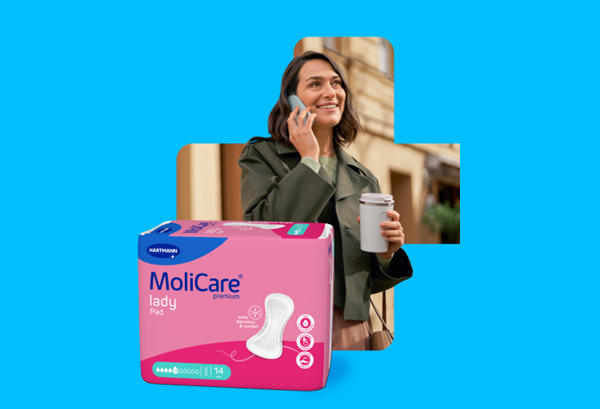
MoliCare incontinence pads
Discover MoliCare Lady Pads incontinence pads with their unique patented SkinGuard absorbent core that instantly absorbs urine for a feeling of dryness. If you experience bladder weakness, light leaks and dribbles, try MoliCare Lady Pads in a range of absorbencies from 1 and 2 drop panty liners to 4 and 5 drop for over night protection.
What Is A Bladder Infection?
Bladder infections, medically called cystitis, are a form of urinary tract infection (UTI) but are also known as urine infections and water infections. But what is a water infection? These infections primarily originate from bacteria that enter the urinary system. These bladder infections are more prevalent in women than men.
This is due to the anatomical differences between genders. Women have a shorter urethra, meaning bacteria has a shorter distance to travel to the bladder. Additionally, the close proximity of the urethra to the anus in women increases the risk of bacteria from the large intestine migrating and causing an infection.
The fastest way to get rid of a bladder infection
- Sources
- What Is A Bladder Infection
- What Causes A Bladder Infection
- Symptoms Of A Bladder Infection
- Bladder Infection Symptoms In Young Children
- How To Get A Bladder Infection Diagnosed
- Finding Treatment For A Bladder Infection
- How To Prevent A Bladder Infection
- The Fastest Way To Get Rid Of A Bladder Infection
- FAQs
What Causes A Bladder Infection?
Many people ask how they can get rid of a UTI in 24 hours, or how do they get rid of bladder infection quickly, but to answer this we must first understand the causes. After all, bladder infections and water infections are usually the result of bacteria intruding on the urinary system. This problem usually originates from the urethra, which can then ascend into the bladder, prompting an infection.
Several factors can increase the likelihood of developing a bladder infection. Being aware of these can help in prevention and early intervention:
-
Sexual Activity: Frequent or recent sexual intercourse can introduce bacteria into the urethra, especially in women.
-
Previous UTIs: A history of urinary tract infections can make you more prone to future occurrences.
-
Birth Control Methods: Using spermicide-coated condoms, diaphragms, or spermicides as standalone birth control can alter the natural bacterial balance, increasing infection risk.
-
Urinary Obstructions: Conditions like kidney stones or ureteral reflux can impede urine flow, creating an environment prone to bacterial growth.
-
Anatomical Irregularities: Structural or functional abnormalities in the urinary tract can increase susceptibility to infections.
-
Diabetes: Those with diabetes may have a compromised immune response, making it harder to fend off bacteria.
-
Urinary Catheters: Prolonged use of a urinary catheter can introduce and harbour bacteria in the bladder.
-
Genetic Factors: Some people may have a hereditary predisposition to UTIs, making them more susceptible.
-
Male-specific Factors: For men, factors such as being uncircumcised or engaging in insertive anal sex can increase the risk.
-
Hygiene Practices: Wiping from back to front after a bowel movement can transfer bacteria to the urethra, especially in women.
Understanding these risk factors is crucial for understanding what is the fastest way to get rid of a bladder infection. If you believe you're at risk, your GP can provide guidance on preventive measures and early detection.

Symptoms Of A Bladder Infection
As you learn about what is the fastest way to get rid of a UTI or bladder infection, you need to be aware of the signs and symptoms. One of the most common symptoms of a water infection or bladder infection is the peeing or needing to pee more than usual. If you're suddenly asking yourself why am I peeing so much and its combined with other symptoms, it could well be the cause is a urine infection. If you or someone you know is experiencing the following symptoms, it may indicate a bladder infection:
-
Pain or Burning Sensation During Urination: This is often the first sign many people notice. It can be sharp or persistent, making peeing uncomfortable.
-
Frequent Urination: The urge to pee more often than usual, even if the volume is minimal.
-
Urgency to Urinate: A sudden need to pee may be harder to control.
-
Hematuria: Presence of blood in the urine, or peeing blood, which can give it a pink or reddish tint.
-
Lower Abdominal Discomfort: A dull ache or pain in the lower abdomen or pelvic region.
-
Altered Urine Appearance: Urine that appears dark, cloudy, or has a potent odour.
-
General Malaise: Feeling unwell, fatigued, or under the weather without a clear reason.
Bladder Infection Symptoms In Young Children
For young children, who might not be able to communicate their discomfort as clearly, additional symptoms to watch out for include:
Fever: A temperature of 100.4° F (38° C) or higher.
Weakness: A noticeable decrease in energy or activity levels.
Irritability: Unexplained fussiness or mood changes.
Reduced Appetite: A sudden disinterest in food or refusal to eat.
Vomiting: Especially if it's recurrent and not linked to another known cause.
Consult your GP if you or a loved one has experienced these symptoms.

How To Get A Bladder Infection Diagnosed
Identifying a bladder infection is crucial for effective treatment to get rid of a bladder infection quickly. Typically, the diagnosis process begins with a simple urine test. This test can provide insights into the presence and nature of the infection.
Here's a breakdown of the diagnostic methods:
Urinalysis: This is a test where the urine is examined for the presence of white blood cells. A higher count of these cells can indicate an ongoing infection in the urinary tract.
Urine Test: Examination of a urine sample in a laboratory. The aim is to encourage the growth of bacteria from the sample. This confirms the presence of an infection and identifies the specific bacteria responsible. Furthermore, it helps in determining the most effective antibiotic for treatment.
For those who experience bladder infections repeatedly, more in-depth diagnostic procedures might be necessary, especially on how to get rid of a bladder infection quickly.
These tests can identify underlying issues in the urinary system or detect the presence of kidney stones:
- Computed Tomography (CT) Scan: This imaging test provides detailed visuals of the urinary tract, helping in spotting abnormalities or obstructions.
- Ultrasound: A non-invasive method, ultrasound uses sound waves to create images of the kidneys, bladder, and surrounding structures.
- Cystoscopy: In this procedure, a thin tube with a camera (cystoscope) is inserted into the urethra to examine the bladder's interior. This is useful in identifying issues within the bladder lining or urethra
MoliCare® Skin Care Products
Explore MoliCare® skin care products which are specifically designed for use on intimate skin without causing irritation
When recovering from a bladder infection, especially for seniors or individuals with limited mobility, frequent bathroom visits can become exhausting and even dangerous on stairs. Installing a stairlift ensures safe and easy access to bathrooms, supporting comfort and independence during recovery.
Finding Treatment For Bladder Infection and UTIs
As you follow our guidance on how to get rid of a bladder infection quickly, you should also be aware of treatment methods that can ease the process.
Antibiotics:
Antibiotics target and eliminate the bacteria responsible for the infection. While they can be highly effective, you should consult your GP regarding your symptoms first. This ensures a thorough eradication of the bacteria and reduces the risk of recurrence.
Pain Management:
Some medications are designed to numb the bladder and urethra, relieving the burning sensation often associated with UTIs. These can be available both over-the-counter and by prescription.
Home Remedies:
As well as medical expertise, several home remedies can help in getting rid of a bladder infection fast:
-
Pain Relievers: Over-the-counter pain medications can help manage discomfort.
-
Stay Hydrated: Drinking fluids can help flush out bacteria. (NOTE: these fluids should not be non-bladder irritants; use these bladder–friendly drinks in your daily routines).
-
Warmth: Applying a hot water bottle to the lower abdomen can soothe pain.
-
Loose Clothing: Wearing non-restrictive clothing can reduce irritation.
-
Frequent Urination: Regularly emptying the bladder can prevent bacterial multiplication.
-
Limit Sexual Activities: Avoid sexual intercourse during an active infection to prevent further irritation.
-
Bed Protection: To further protect your sleeping routines from potential bladder infection leaks, consider using incontinence bed protection.
How To Prevent A Bladder Infection
To prevent a bladder infection, you must understand what’s good for bladder infections, to ease and relieve pain. Increasing fluid intake, for instance, can aid in flushing out potential irritants and bacteria from the urinary system. Additionally, urinating immediately after intercourse is recommended. While there isn't concrete evidence to suggest this directly prevents bladder infections, urinating can help expel germs that might have entered the bladder during sex.
Switching to alternative birth control methods might also reduce the risk of bladder infections. For postmenopausal women, vaginal oestrogen can be beneficial too. If you or someone that you know has become pregnant, make sure to be aware of the correlation between pregnancy and incontinence.
Maintaining good hygiene practices is also important to prevent a bladder infection. For example, wiping from front to back after bowel activity can prevent the transfer of bacteria from the anal region to the urethra. Use MoliCare® Skin Moist Tissues after using the toilet for a thorough cleanse without irritating the skin.
Further tips to prevent a future bladder infection include:
- Regularly drinking 8 cups of water.
- Urinate when necessary.
- Changing underwear daily.
Changes in diet (if recommended by GP).
MoliCare® Incontinence Bed Protection
The Fastest Way To Get Rid Of A Bladder Infection
In truth, the fastest way to get rid of a bladder infection is by consulting your GP. Of course, you are welcome to follow the tips and guidelines recommended in this article, but these should only be brought forward once your bladder infection has been diagnosed. For further tips and guidance regarding bladder and other incontinence-related issues in regards to how to control and prevent cystitis.
FAQs
Can you flush out a bladder infection?
Drinking plenty of water can help flush bacteria from the urinary system, potentially reducing the severity or duration of the infection. However, water alone is unlikely to completely cure a bladder infection, especially if it's more severe or caused by resistant bacteria. Antibiotics prescribed by your GP will aid in treating and eliminating the infection.
How long does it take to flush out a bladder infection?
The duration of a bladder infection varies depending on its severity and the treatment used. With appropriate antibiotic treatment, symptoms usually improve within 1-3 days. Without treatment, the infection can persist, worsen, or spread to the kidneys.
Do incontinence pads cause bladder infections?
No. Using a good quality incontinence pad will absorb urine and take it away from the skin. It is important to maintain good hygiene practices, cleaning intimate skin areas and changing pads or pants at appropriate intervals or at least every 8 hours.
Why am I peeing so much all of a sudden?
There could be a number of reasons, simply consuming much more fluids than usual, taking a type of medication call diuretics could be the cause, or a water infection (or UTI) could be the cause. Consider if there have been any changes in your daily habits, or medications and consider if you have any other symptoms which could indicate you have a UTI.
Do I have to see my doctor to treat a UTI?
No. You can visit Weldricks Pharmacy First service where a Pharmacist will be able to assess and prescribe treatment without the need for a doctors appointment.
Can I buy treatments myself for a UTI or Cystitis?
Yes. There are supplements you can buy at Weldricks online pharmacy to ease the symptoms of Cystitis and have them delivered directly to your home. Most mild cases will clear up after a few days but if you are concerned visit your local pharmacist or GP.
Sources
Lloyds Pharmacy (n.d.) Spermicide. [online] Available at: https://lloydspharmacy.com/blogs/sexual-health/spermicide [accessed 20/09/23]
GOV.UK. (n.d.) Urinary Tract Infection: Diagnostic Tools For Primary Care. [online] available at: https://www.gov.uk/government/publications/urinary-tract-infection-diagnosis [accessed 20/09/23]
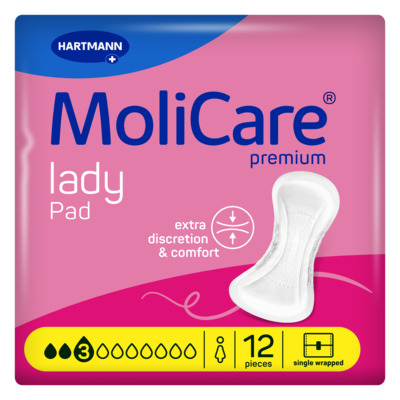 MoliCare® Premium Lady Pad 3 Drops (ISO 506ml)
<h3><strong>Highly absorbent and discreet incontinence pads for women</strong></h3>
<p>Feel confident all day with MoliCare® premium lady Pad 3 drops. These thin and discreet incontinence pads for women offer extra protection for light bladder weakness that keeps you dry for up to 12 hours<sup>2</sup>.</p>
<p>With their <strong>new and patented MoliCare SkinGuard® Absorbent Core Technology</strong>, the pads absorb urine up to 83 %<sup>1</sup> faster, <strong>giving you an instant-dry feeling</strong>, even with sudden gushes of urine. The unique absorbent core also offers advanced skin protection, helping to maintain skin health in the intimate area.</p>
<p>These women’s feminine pads stay securely in place in your underwear, thanks to its wide adhesive strip. Plus, the <strong>up to 29 %<sup>1</sup> thinner</strong> design with soft material and elastic and soft side-barriers give you a more discreet fit and increased wearing comfort throughout the day.</p>
<p>MoliCare® premium lady Pad 3 drops are <strong>individually wrapped for hygienic use</strong>. Dermatologically tested, they do not contain perfume, colours<sup>3</sup> or latex.</p>
<p><sup>1</sup>Compared to last generation<br />
<sup>2</sup>Hours will vary depending on amount of urine and individual bladder habits<br />
<sup>3</sup>With no printing colours</p>
MoliCare® Premium Lady Pad 3 Drops (ISO 506ml)
<h3><strong>Highly absorbent and discreet incontinence pads for women</strong></h3>
<p>Feel confident all day with MoliCare® premium lady Pad 3 drops. These thin and discreet incontinence pads for women offer extra protection for light bladder weakness that keeps you dry for up to 12 hours<sup>2</sup>.</p>
<p>With their <strong>new and patented MoliCare SkinGuard® Absorbent Core Technology</strong>, the pads absorb urine up to 83 %<sup>1</sup> faster, <strong>giving you an instant-dry feeling</strong>, even with sudden gushes of urine. The unique absorbent core also offers advanced skin protection, helping to maintain skin health in the intimate area.</p>
<p>These women’s feminine pads stay securely in place in your underwear, thanks to its wide adhesive strip. Plus, the <strong>up to 29 %<sup>1</sup> thinner</strong> design with soft material and elastic and soft side-barriers give you a more discreet fit and increased wearing comfort throughout the day.</p>
<p>MoliCare® premium lady Pad 3 drops are <strong>individually wrapped for hygienic use</strong>. Dermatologically tested, they do not contain perfume, colours<sup>3</sup> or latex.</p>
<p><sup>1</sup>Compared to last generation<br />
<sup>2</sup>Hours will vary depending on amount of urine and individual bladder habits<br />
<sup>3</sup>With no printing colours</p>
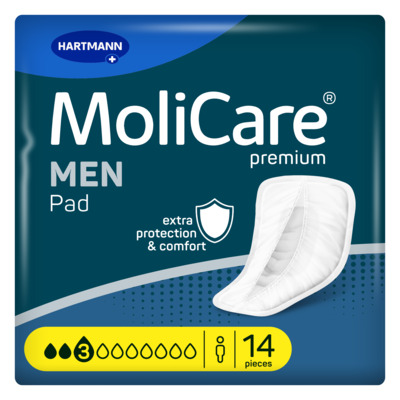 MoliCare® Premium MEN Pad 3 Drops (ISO 441ml)
<h2>Why choose MoliCare<sup>®</sup> pads for men?</h2>
<p>Improved incontinence pads for men with <strong>up to 86%* faster absorption</strong></p>
<ul>
<li>For men experiencing light bladder weakness</li>
<li>Engineered for men with discreet V-shape design</li>
<li>With <strong>anti-leak guards</strong> for reliable all-round leakage protection</li>
<li><strong>New</strong> <strong>MoliCare</strong><strong> SkinGuard</strong><sup>®</sup><strong> Absorbent Core Technology</strong> for instant-dry feeling with advanced skin protection</li>
<li>Feels <strong>up to 90%* drier</strong></li>
<li>Neutralises unpleasant odours</li>
<li>Stays in place thanks to the wide adhesive strip</li>
<li>Product size: 27 cm long x 18 cm wide</li>
</ul>
<p>*Compared to last generation</p>
MoliCare® Premium MEN Pad 3 Drops (ISO 441ml)
<h2>Why choose MoliCare<sup>®</sup> pads for men?</h2>
<p>Improved incontinence pads for men with <strong>up to 86%* faster absorption</strong></p>
<ul>
<li>For men experiencing light bladder weakness</li>
<li>Engineered for men with discreet V-shape design</li>
<li>With <strong>anti-leak guards</strong> for reliable all-round leakage protection</li>
<li><strong>New</strong> <strong>MoliCare</strong><strong> SkinGuard</strong><sup>®</sup><strong> Absorbent Core Technology</strong> for instant-dry feeling with advanced skin protection</li>
<li>Feels <strong>up to 90%* drier</strong></li>
<li>Neutralises unpleasant odours</li>
<li>Stays in place thanks to the wide adhesive strip</li>
<li>Product size: 27 cm long x 18 cm wide</li>
</ul>
<p>*Compared to last generation</p>
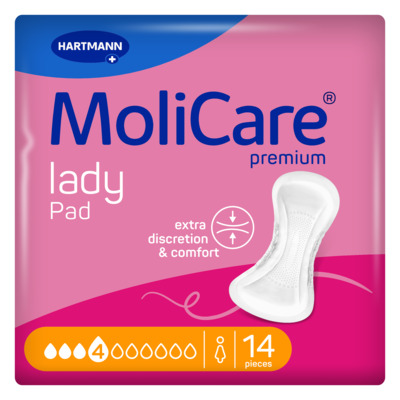 MoliCare® Premium Lady Pad 4 Drops (ISO 841ml)
<h2>Why choose MoliCare<sup>®</sup></h2>
<ul>
<li>Extra-long incontinence pads <strong>for women with moderate bladder weakness</strong></li>
<li>With soft side barriers for extra leakage protection</li>
<li><strong>Up to 29%</strong><sup>1</sup><strong> thinner</strong> for more discretion</li>
<li><strong>New MoliCare SkinGuard<sup>®</sup> Absorbent Core Technology</strong> with advanced skin protection absorbs urine up to 83%<sup>1</sup> faster and neutralises unpleasant odours</li>
<li><strong>Up to 12 hours<sup>2</sup> of dryness</strong> for a fresh feeling and greater confidence</li>
<li>Helps prevent skin irritation in the intimate area and <strong>maintain intimate skin-health</strong></li>
<li>Comfortable to wear with a wide adhesive strip for a secure fit inside your underwear</li>
<li>Perfume-free and colour<sup>3 </sup>free incontinence pads providing a more sustainable solution </li>
<li>Dermatologically tested</li>
<li>Product size: 40 cm long x 16.2 cm wide</li>
</ul>
MoliCare® Premium Lady Pad 4 Drops (ISO 841ml)
<h2>Why choose MoliCare<sup>®</sup></h2>
<ul>
<li>Extra-long incontinence pads <strong>for women with moderate bladder weakness</strong></li>
<li>With soft side barriers for extra leakage protection</li>
<li><strong>Up to 29%</strong><sup>1</sup><strong> thinner</strong> for more discretion</li>
<li><strong>New MoliCare SkinGuard<sup>®</sup> Absorbent Core Technology</strong> with advanced skin protection absorbs urine up to 83%<sup>1</sup> faster and neutralises unpleasant odours</li>
<li><strong>Up to 12 hours<sup>2</sup> of dryness</strong> for a fresh feeling and greater confidence</li>
<li>Helps prevent skin irritation in the intimate area and <strong>maintain intimate skin-health</strong></li>
<li>Comfortable to wear with a wide adhesive strip for a secure fit inside your underwear</li>
<li>Perfume-free and colour<sup>3 </sup>free incontinence pads providing a more sustainable solution </li>
<li>Dermatologically tested</li>
<li>Product size: 40 cm long x 16.2 cm wide</li>
</ul>
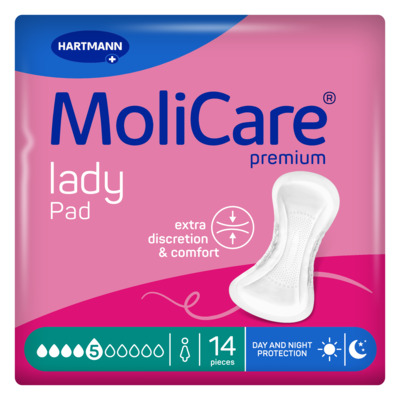 MoliCare® Premium Lady Pad 5 Drops (ISO 1045ml)
<h2>Why choose MoliCare<sup>®</sup></h2>
<ul>
<li>Extra-long incontinence pads <strong>for women with moderate bladder weakness</strong></li>
<li>Nighttime incontinence pad with soft side barriers for extra leakage protection at night</li>
<li><strong>Up to 29%<sup>1</sup> thinner</strong> for more discretion</li>
<li><strong>New MoliCare SkinGuard<sup>®</sup> Absorbent Core Technology</strong> with advanced skin protection absorbs urine up to <strong>83%</strong><sup>1</sup> faster and neutralises unpleasant odours</li>
<li><strong>Up to 12 hours<sup>2</sup> of dryness</strong> for a fresh feeling and greater confidence during day and night</li>
<li>Keeps skin dry through the night, helping protect the intimate area and <strong>maintain skin’s pH balance</strong></li>
<li>Comfortable to wear with a wide adhesive strip for a secure fit inside your underwear </li>
<li>Perfume-free and colour-free<sup>3</sup> incontinence pads providing a more sustainable solution </li>
<li>Dermatologically tested</li>
<li>Product size: 40 cm long x 16.2 cm wide</li>
</ul>
MoliCare® Premium Lady Pad 5 Drops (ISO 1045ml)
<h2>Why choose MoliCare<sup>®</sup></h2>
<ul>
<li>Extra-long incontinence pads <strong>for women with moderate bladder weakness</strong></li>
<li>Nighttime incontinence pad with soft side barriers for extra leakage protection at night</li>
<li><strong>Up to 29%<sup>1</sup> thinner</strong> for more discretion</li>
<li><strong>New MoliCare SkinGuard<sup>®</sup> Absorbent Core Technology</strong> with advanced skin protection absorbs urine up to <strong>83%</strong><sup>1</sup> faster and neutralises unpleasant odours</li>
<li><strong>Up to 12 hours<sup>2</sup> of dryness</strong> for a fresh feeling and greater confidence during day and night</li>
<li>Keeps skin dry through the night, helping protect the intimate area and <strong>maintain skin’s pH balance</strong></li>
<li>Comfortable to wear with a wide adhesive strip for a secure fit inside your underwear </li>
<li>Perfume-free and colour-free<sup>3</sup> incontinence pads providing a more sustainable solution </li>
<li>Dermatologically tested</li>
<li>Product size: 40 cm long x 16.2 cm wide</li>
</ul>
